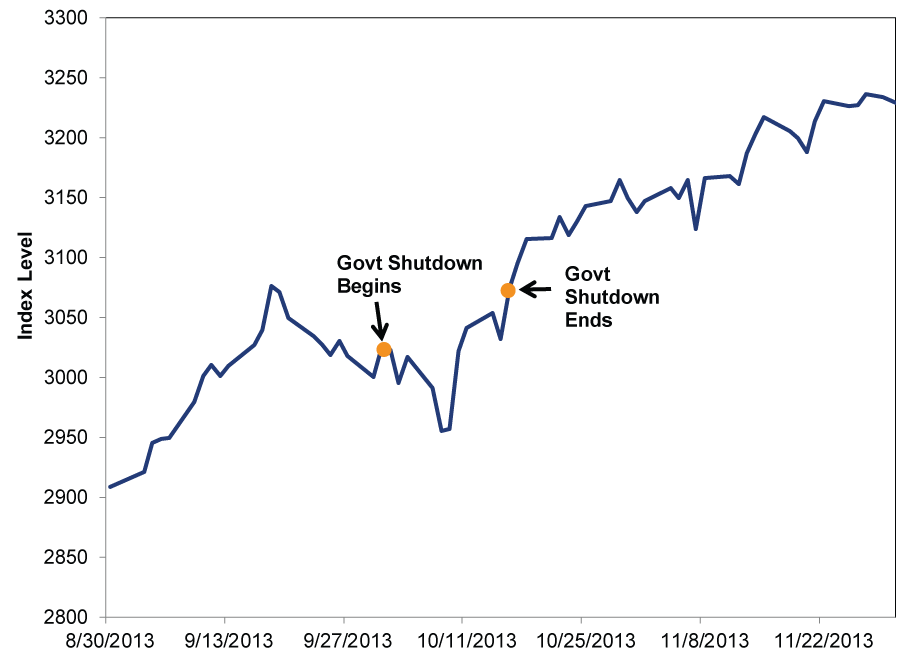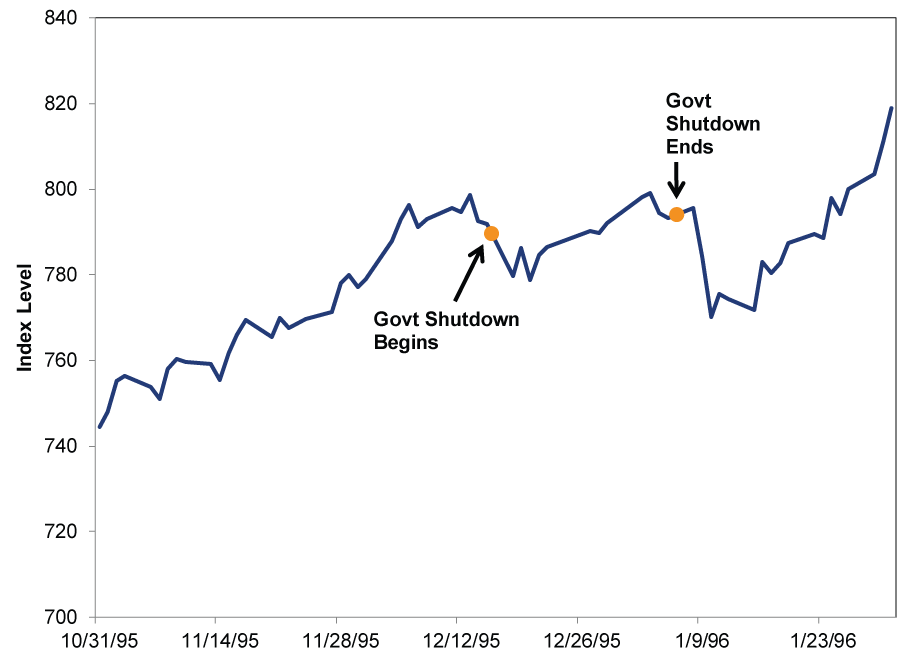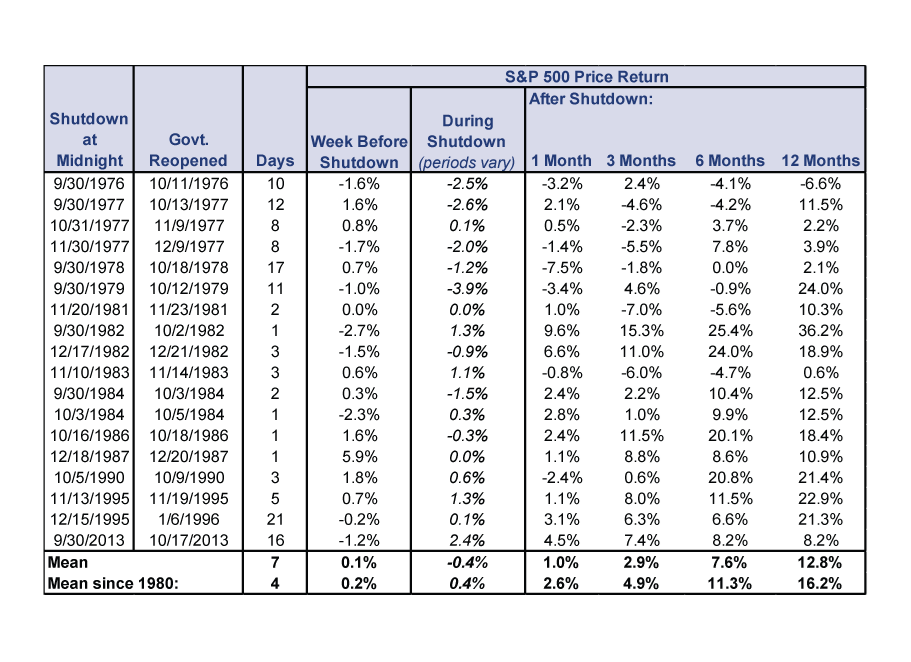Personal Wealth Management / Market Analysis
Shut Down Shutdown Fears
History shows government shutdowns don’t shut down stocks.
Editors’ Note: Our discussion of politics is focused purely on potential market impact and is designed to be nonpartisan. Stocks don’t favor any party, and partisan ideology invites bias—dangerous in investing.
With Halloween around the corner, frightful things seemingly abound. A ghost from 2013 lurks in the not-too-distant future: a government shutdown. Eek! Both congresspeople and the president alike have hinted at one recently. If the impasse persists—as some headlines are forecasting—the federal government will close a bunch of agencies’ doors come December 8. But before you start worrying, here is a friendly reminder: government shutdowns don’t doom stocks, as markets can do just fine even if Washington decides to close up shop for a bit.
Shutdown chatter has swirled for most of this year as Congress toyed with government funding. Lawmakers reached a late agreement and kicked the can back in May. The White House and congressional leaders—including some notable Democrats—then agreed to a deal in September that kept the government funded through early December. With that deadline now only weeks away, Congress is (unsurprisingly) at odds over several issues, including a border wall, immigration, health care subsidies and hurricane relief. Coming to terms on a spending bill may be a tall order—and no deal means a shutdown.
A shutdown doesn’t mean everything in D.C. comes to a grinding halt. Many government services and agencies close—those the government deems “non-essential”—but some functions will continue. For example, during the 2013 government shutdown, national parks[i] were closed to the public. However, active military remained on the job. Overall, government employees and contractors felt the biggest impact, as did folks attempting to interact with federal government employees engaged in research of one form or another.[ii]
While shutdowns inconvenience a lot of people, the market fallout tends to be pretty limited. Going back to 2013, headlines shrieked about the possibility of a shutdown come October 1. Debt ceiling worries tagged along, driving concerns about not having a government and fears of potential default[iii]—a pretty apt preview of what might be in store this time around.
You probably remember what happened next: The government did indeed shut down from October 1 – October 16. Stocks largely shrugged in response.
Exhibit 1: S&P 500 and the 2013 Government Shutdown

Source: FactSet, as of 10/13/2017. S&P 500 Total Return, from 8/30/2013 – 11/30/2013.
Looking more broadly, the 2013 government shutdown didn’t seem to faze stocks much at all. For the year, the S&P 500 ended up 32.4%.[iv]
2013 also isn’t an outlier. We can go back to December 1995 – January 1996, when the government shut down for 21 days—the longest on record. Stocks didn’t crash then, either.
Exhibit 2: S&P 500 and the December 1995 Government Shutdown

Source: FactSet, as of 10/25/2017. S&P 500 Total Return, from 10/31/1995 – 1/30/1996.
Clearly, D.C. antics don’t provide the oomph to derail a bull market—even when pols make good on their threats to close government agencies!
History confirms this is the case, too. Since 1976, the government has shut down 18 times. While we advise folks against focusing on narrow slices of time, the data show shutdowns don’t tend to have a lasting—if any—meaningful effect on stocks.
Exhibit 3: Government Shutdowns Don’t Shut Down Stocks

Source: FactSet, Congressional Research Service, Fisher Investments Research, as of 10/25/2017.
One note: Before 1980, fewer government agencies closed during shutdowns. The government’s stricter interpretation of the Antideficiency Act meant more sweeping closures since then, which makes post-1980 data more apt for comparing more recent shutdowns. But even with more offices temporarily closed, stocks overall didn’t seem to mind.
While government shutdowns tend to garner a lot of press, the economic fallout isn’t huge. Simply, the government doesn’t drive the American economy—the private sector does. Government consumption and investment comprises only about 13% of US GDP, and the rest is private industry.[v] So even if the rhetoric starts picking up in D.C. and various pols threaten to shut things down, we suggest tuning that noise out. Overall, the US economy remains in fine shape, with more economic growth likely for the foreseeable future. That shouldn’t change even if Washington shuts its doors for a little while.
[i] Including the Smithsonian! Except security guards and employees who feed the animals at the National Zoo. They reported to work.
[ii] Which includes your friendly MarketMinder editors, who were quite pained when the Commerce Department’s economic data went offline.
[iii] Which were always misperceived, in our view.
[iv] Source: FactSet, as of 10/25/2017. S&P 500 Total Return Index, from 12/31/2012 – 12/31/2013.
[v] Source: BEA, as of 10/25/2017. Value added by industry as a percentage of GDP in 2016.
If you would like to contact the editors responsible for this article, please message MarketMinder directly.
*The content contained in this article represents only the opinions and viewpoints of the Fisher Investments editorial staff.
Get a weekly roundup of our market insights
Sign up for our weekly e-mail newsletter.

You Imagine Your Future. We Help You Get There.
Are you ready to start your journey to a better financial future?

Where Might the Market Go Next?
Confidently tackle the market’s ups and downs with independent research and analysis that tells you where we think stocks are headed—and why.





